Hyena << hy EE nuh >> is a social mammal whose powerful jaws and big, strong teeth can crush bone. Working together, a clan of hyenas can hunt and kill a buffalo or even a young rhinoceros. Hyenas also scavenge for food—that is, they eat the remains of animals they find dead. Their hunting and scavenging abilities make them adaptable animals that can thrive in a range of habitats, even where people have settled.
Hyenas have many characteristics in common with dogs and wolves. For example, their teeth resemble a dog’s teeth. However, hyenas are more closely related to cats than they are to dogs. Hyenas’ closest living relatives are viverrids, a group that includes mongooses and the catlike civets.

The body of a hyena
Hyenas have a unique, recognizable body shape. A hyena’s front legs are longer than its hind legs, making its back sloped. A hyena has a thick neck and a large head. The large head supports powerful jaws, which are the strongest jaws of any mammal. An adult hyena could crush a bowling ball with its bite. The strong jaws help hyenas kill prey and bite through the bones of carrion (dead animals).
A hyena’s stomach contains acids that digest skin, hooves, bone, and teeth. This ability makes hyenas excellent scavengers. Most predators, such as lions, cannot digest these body parts. When they hunt an animal and eat its flesh, they leave these body parts behind. Hyenas can then eat these leftover parts. There are a few body parts that even hyenas cannot digest, such as horns. When hyenas consume these body parts, they regurgitate them later.
Hyenas have a strong immune system. They are unusually resistant to serious infectious diseases, such as rabies and anthrax. This resistance helps them survive eating animals killed by such diseases.
Hyenas use their senses to find prey, recognize their home, and communicate with other hyenas. They have an excellent sense of smell. They use scent to mark their territory. Hyenas also have good hearing. They can identify other hyenas by their calls. They can see about as well as a dog. They probably see few colors.
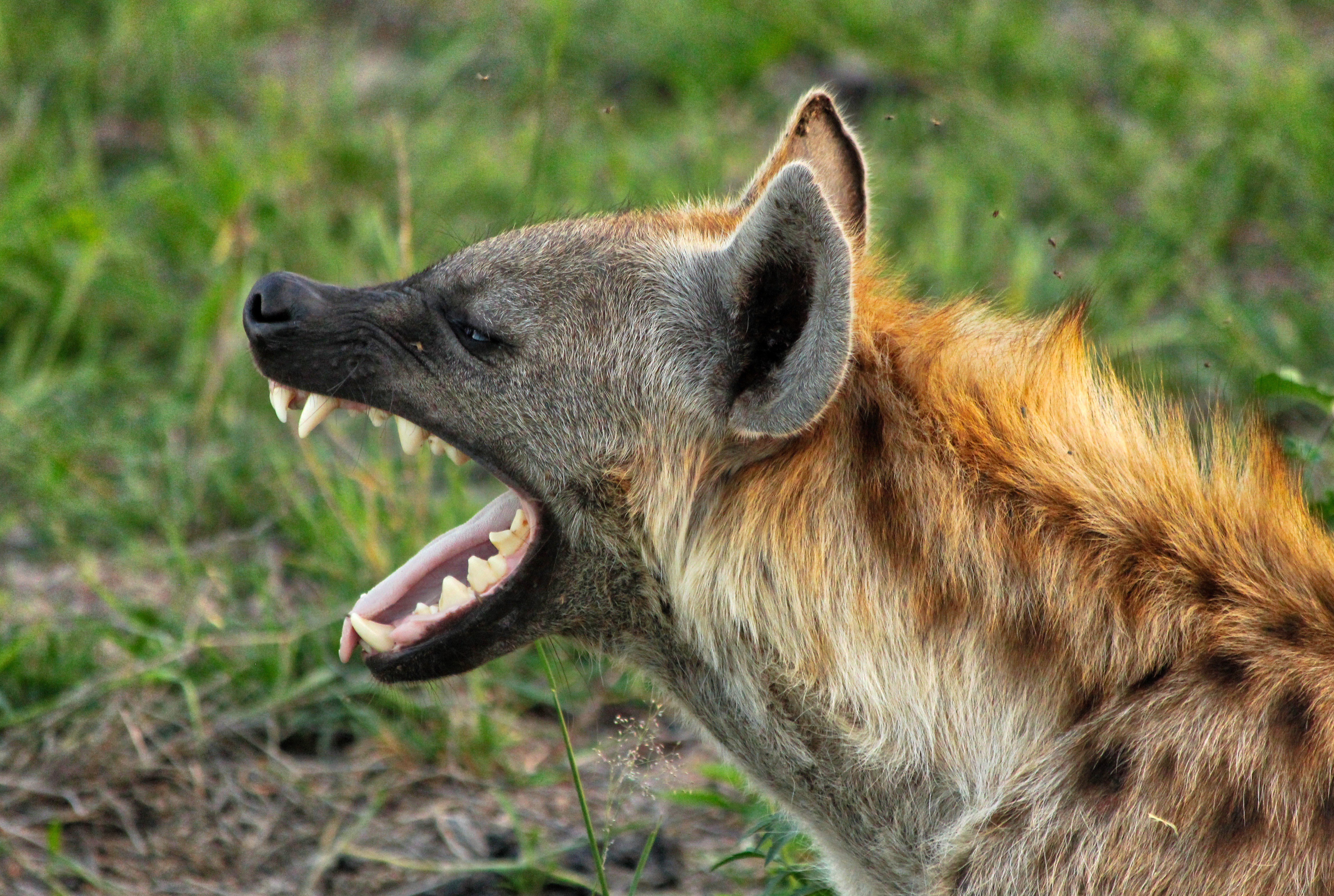
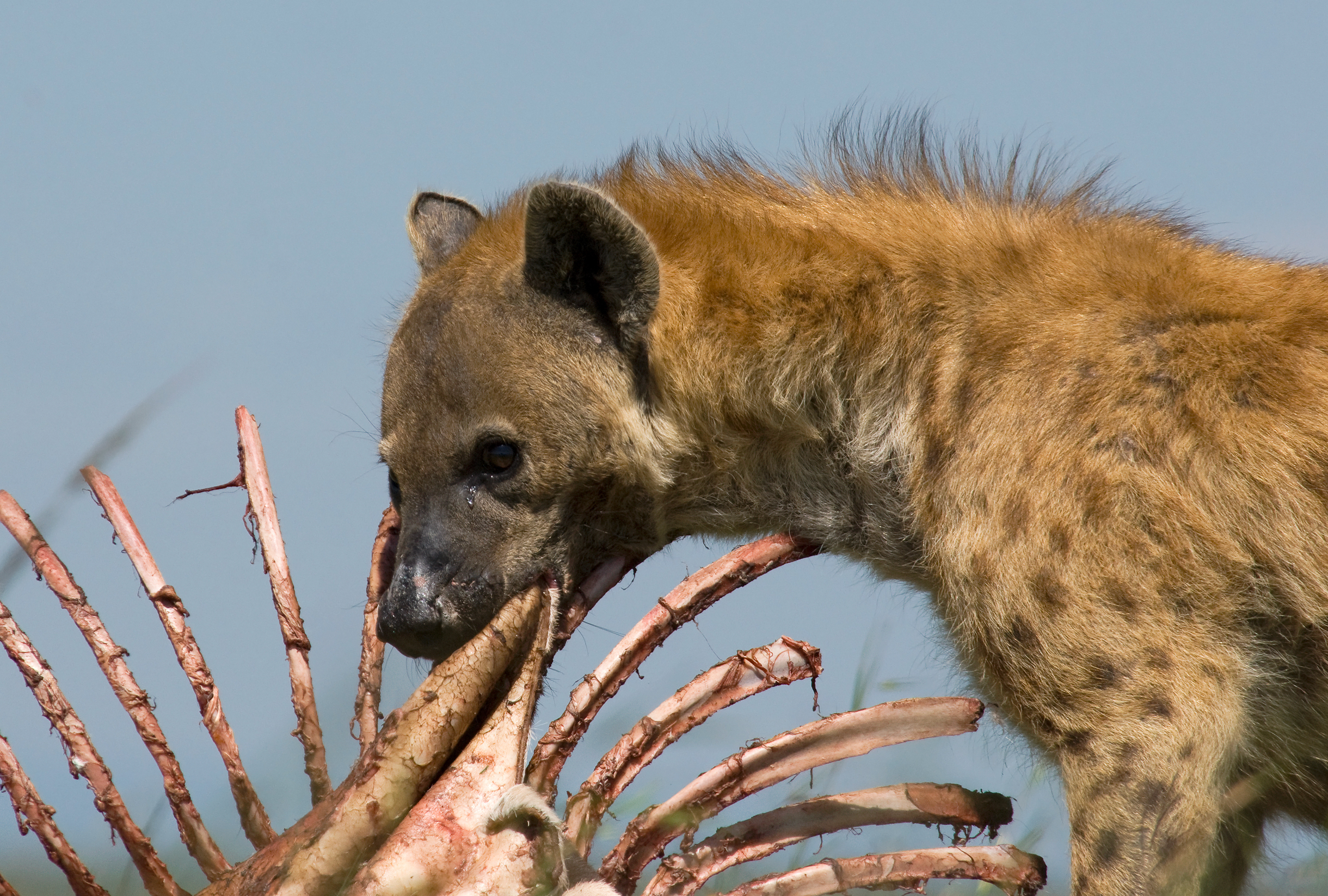
Hyenas
Kinds of hyenas
Four members of the hyena family exist today: three kinds of hyenas, and the aardwolf. For information about the aardwolf, see Aardwolf. The three kinds of hyenas are the spotted hyena, the striped hyena, and the brown hyena. Scientists know more about spotted hyenas than about the other kinds. The three kinds of hyenas are similar in appearance and body structure, but they follow different ways of life.

Spotted hyenas
are the largest and most common hyenas. Tens of thousands of years ago, spotted hyenas were found across Africa, Europe, and Asia. Today, they live only in Africa south of the Sahara. They live in savannas, scrublands, and, sometimes, forests and swamps.
Unlike other hyenas, spotted hyenas have rounded ears. Their coarse fur is yellow or grayish with dark spots. The fur on their back and shoulders is long, making it seem like they have a mane. Adult spotted hyenas weigh 88 to 190 pounds (40 to 86 kilograms). They stand 2 1/2 feet (76 centimeters) high at the shoulder.
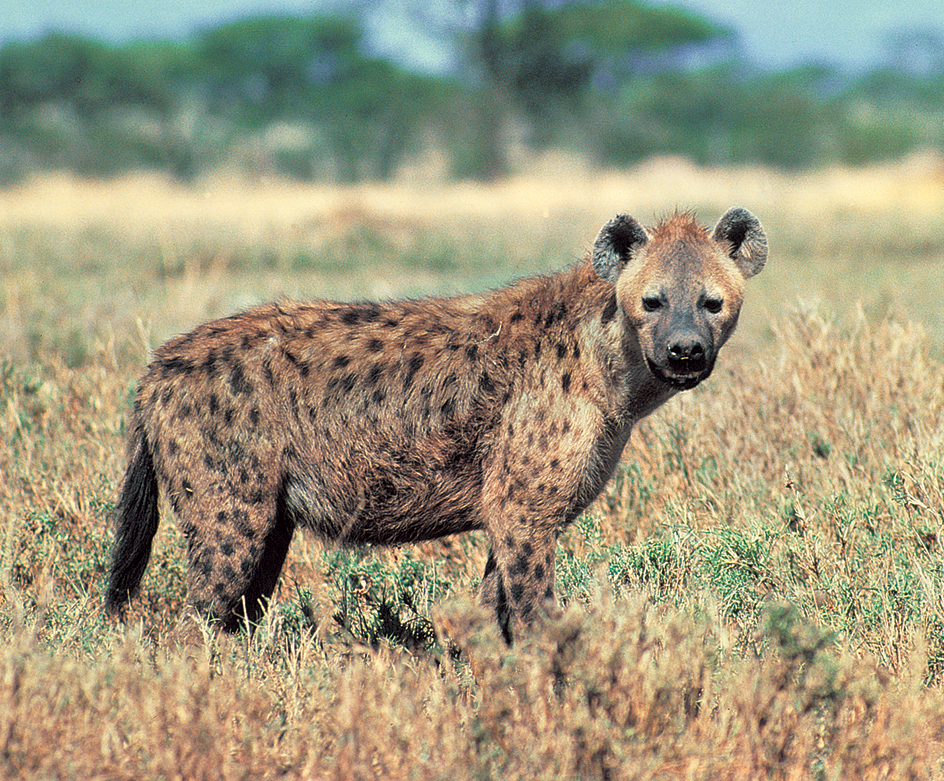
Females are slightly bigger than males. Otherwise, female and male spotted hyenas appear identical. Females even have external genitals that look like male reproductive organs.
Spotted hyenas have complex social relationships. They are organized into clans. A single clan can have as many as 100 hyenas. The hyenas in a clan work together to find food and defend the clan’s territory. Clans have a dominance hierarchy—that is, each individual has a ranked social status within the clan. The dominance hierarchy establishes the order in which clan members access food and other resources. The highest-ranked members of a clan eat first. 
Spotted hyena clans are matriarchal (controlled by females). Female spotted hyenas socially dominate males. The lowest-ranking female in a clan outranks the highest-ranking male. Female spotted hyenas stay in their mother’s clan for life. Adult male hyenas leave their mother’s clan to join a different clan. When a new male joins a clan, he becomes the clan’s lowest-ranked individual.
Spotted hyenas hunt in a group or alone. Large groups can kill young rhinos and adult wildebeest, zebras, and buffalo. Small groups hunt gazelles, impalas, warthogs, and other animals of similar size. A lone spotted hyena hunts rabbits, springhares, foxes, porcupines, jackals, or fish. Hyenas can run for a long time without becoming tired.
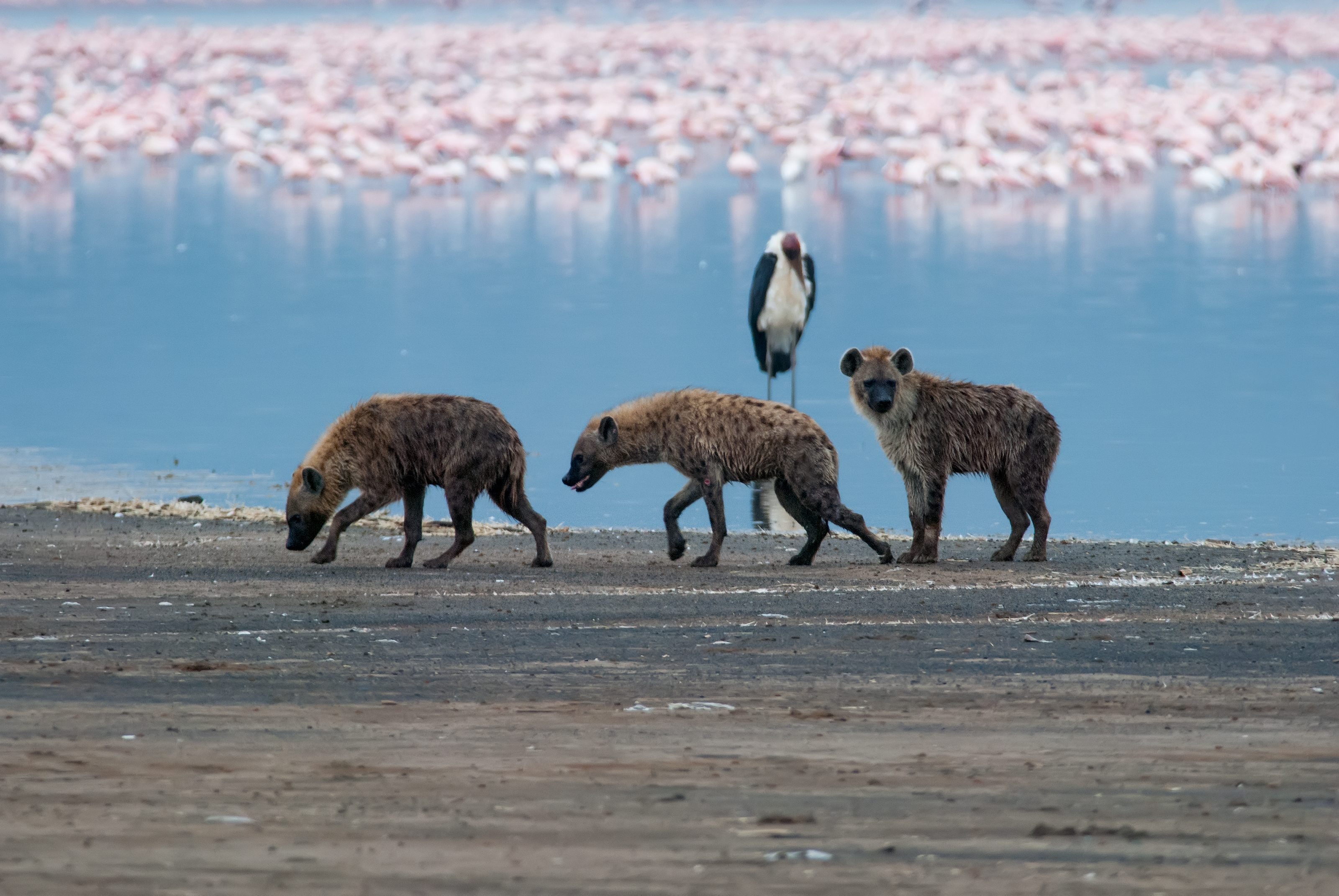

Spotted hyenas often compete with lions for food. Sometimes lions steal hyenas’ freshly killed prey, and sometimes hyenas steal prey from lions.
Spotted hyenas are strong swimmers. They can even dive to the bottom of a lake to scavenge from a sunken carcass. Spotted hyenas sometimes save leftover food for later by burying it.
Spotted hyenas are sometimes called laughing hyenas because their howl sounds like a hysterical human laugh. They also use a loud “whoop” call to communicate with other spotted hyenas over long distances. They whoop to tell other clan members where they are or to call for help. Loading the player...
Spotted hyena
Spotted hyenas can be active at any time, but they are most often active at night. During the day, they rest in holes, in shallow pools, or under bushes, where they can shelter from the sun.
About three and a half months after mating, a female spotted hyena gives birth in a den. Usually, two cubs are born. Cubs have dark fur. They gradually develop spots as they grow into adults. Spotted hyenas mature by the time they are 3 years old. They live for about 20 years.
Striped hyenas
are found in northern Africa and from Turkey to India in Asia. They live in somewhat dry habitats, including scrublands and savannas. But they do not live in true deserts, because they must have water close by.


Striped hyenas are smaller than spotted hyenas. Adult striped hyenas stand 28 inches (71 centimeters) high at the shoulder. They weigh 60 to 90 pounds (27 to 41 kilograms). Their grayish coats have narrow black stripes across the body and legs. Their ears are pointed.
Striped hyenas scavenge most of their food. They also hunt small animals and insects, and eat such fruits as melons and peaches.
Striped hyenas spend their time alone or in small groups. They are active at night. During the day, they usually rest in caves or dens.
Striped hyenas are generally quiet and not aggressive. They have a loud howl, but they rarely use it. When they encounter people or other animals, they usually hide. If a striped hyena needs to scare a predator away, it raises the hair along its back to appear much larger than it really is. 
A female striped hyena carries her cubs for three months before giving birth. Usually, two to four cubs are born. Striped hyena cubs are born with their eyes and ears closed. Their fur looks similar to an adult’s, but they have no mane. The mother cares for her cubs for a year. They mature at 2 to 3 years old. In the wild, their lifespan is 10 to 12 years.
Brown hyenas
live in southern Africa, south of the Zambezi River. Like striped hyenas, they live in savannas and dry grasslands. But they also live in deserts. They eat more fruit than other hyenas do. They favor watery fruits such as melons. The water in the fruit helps them survive drier conditions.
Adult brown hyenas weigh 70 to 160 pounds (32 to 73 kilograms). They stand 31 inches (79 centimeters) high at the shoulder. Their coarse, blackish-gray coat has long hair on the back and stripes only on the legs. Their ears are long and pointed. Their tail is short and bushy.
Some brown hyenas live alone and wander across the land. Others live in clans that defend a specific territory. Brown hyena clans have separate male and female dominance hierarchies. Unlike spotted hyenas, socially dominant male brown hyenas rank equally to dominant females. Brown hyenas bite, wrestle, and threaten each other to establish dominance. Clans live together in a den.
Brown hyenas look for food at night. In addition to fruits, their diet includes springboks, springhares, gemsboks, zebras, fur seal pups, jackals, and birds. Brown hyenas often bury leftover food to eat the next day.
Brown hyenas are hunted by lions and occasionally by spotted hyenas. Lions, jackals, and wild dogs hunt their cubs.
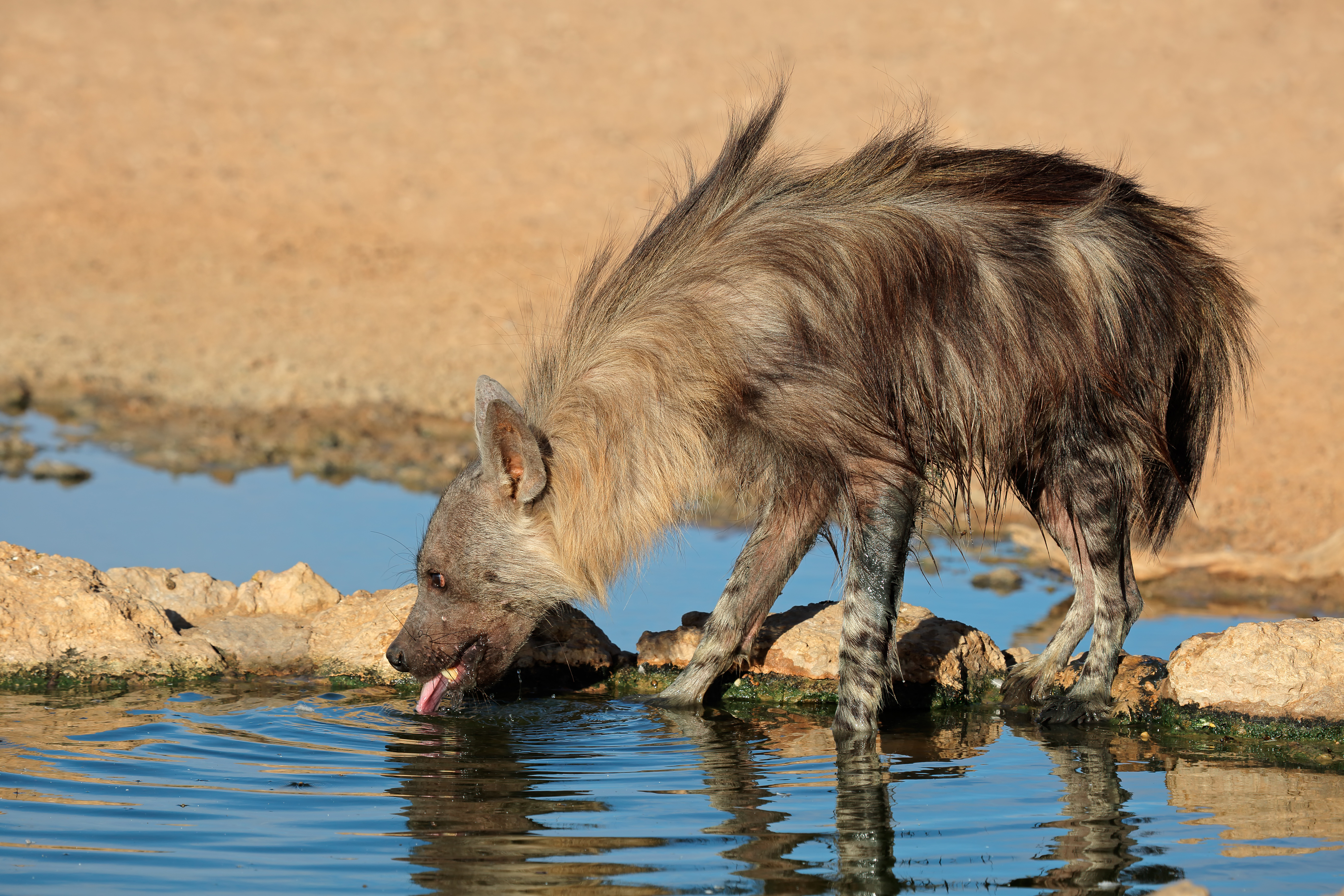
Hyenas and people
Unlike other large predators, hyenas have adapted well to human settlement. Their excellent scavenging abilities allow them to live where people live. In some towns and cities, hyenas roam the streets at night eating garbage and dead animals. In towns with organized waste disposal, hyenas often gather at landfills. But hyenas generally avoid direct encounters with people.
However, hyenas and people often come into conflict when they are living in the same area. Hyenas occasionally kill livestock or eat crops such as melons. As a result, farmers sometimes shoot or poison hyenas. Hunters kill hyenas to sell their body parts for use in traditional medicine. Hyenas are frequently hit by cars, especially when they stop on roads to feed on roadkill.
Local beliefs may influence how people treat hyenas. In many myths and folk tales, hyenas are depicted as greedy, cowardly, or stupid. Some cultures consider hyenas to be evil or supernatural. In areas of southern Africa, witches are said to travel by riding on hyenas’ backs. However, many people appreciate hyenas because their scavenging cleans up waste.
Hyenas are not endangered (at risk of becoming extinct in the near future). But scientists think striped and spotted hyena populations are declining. The striped hyena is widespread, but it is likely to disappear from some parts of its range.

